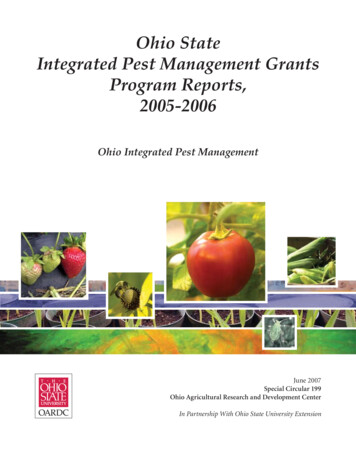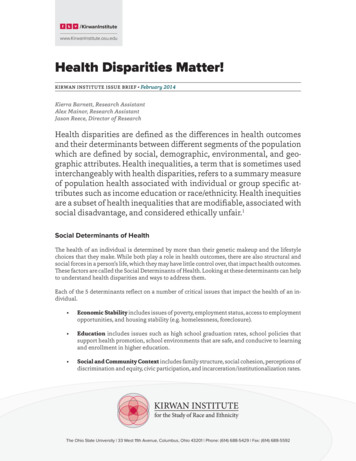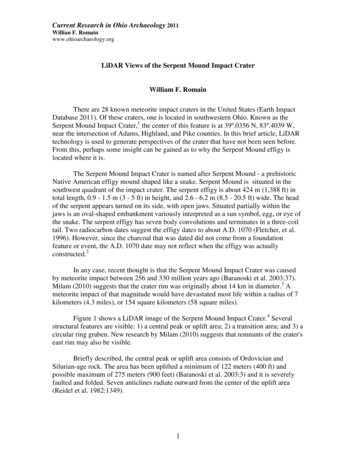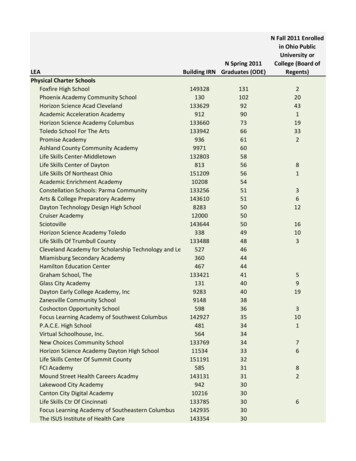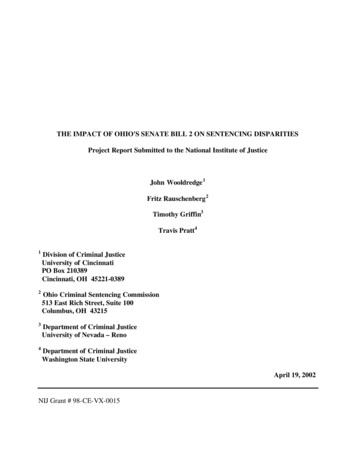
Transcription
THE IMPACT OF OHIO'S SENATE BILL 2 ON SENTENCING DISPARITIESProject Report Submitted to the National Institute of JusticeJohn Wooldredge 1Fritz Rauschenberg 2Timothy Griffin3Travis Pratt41Division of Criminal JusticeUniversity of CincinnatiPO Box 210389Cincinnati, OH 45221-03892Ohio Criminal Sentencing Commission513 East Rich Street, Suite 100Columbus, OH 432153Department of Criminal JusticeUniversity of Nevada – Reno4Department of Criminal JusticeWashington State UniversityApril 19, 2002NIJ Grant # 98-CE-VX-0015
AcknowledgmentsThe authors acknowledge with gratitude the cooperation and assistance provided by prosecutoroffices, probation departments, and APA offices throughout the 24 Ohio counties examined for thestudy.We would also like to thank the Center for Criminal Justice Research at the University ofCincinnati for housing the project.Supported under award No. 98-CE-VX-0015 from the National Institute of Justice, Office ofJustice Programs, U.S. Department of Justice. Points of view in this report are those of the authorsand do not necessarily represent the official position of the U.S. Department of Justice.2
Executive SummarySentencing disparities based on the extra- legal characteristics of defendants (such as race)violate the premise of due process and hinder the goal of proportionality in punishment (Crew,1991). One goal of recent truth in sentencing policies has been to reduce such disparities throughthe use of fairly rigid determinate sentencing schemes, which appear to have been effective inFlorida and Minnesota (Bales, 1997; Stolzenberg and D'Allessio, 1994). However, Ohio's reforms(through Senate Bill 2, SB2) involved the implementation of a set of guidelines that are less rigidthan typical determinate sentencing schemes such as those used in Florida and Minnesota. Aresearch partnership between the Ohio Sentencing Commission and the Division of CriminalJustice at the University of Cincinnati examined whether the impact of extra-legal characteristicson the case outcomes of indicted felons has been reduced significantly under Ohio's new scheme.The research team also investigated whether particular legal and extra-legal influences on caseoutcomes operate differently between race/ethnic groups, and whether such differences werereduced significant ly after the implementation of SB2. Given that other aspects of case processingmay have also changed under the new guidelines as a consequence of court participants anticipatingcase outcomes, other stages of case processing were also examined (e.g., dropped charges andcharge reductions). Support for the effectiveness of such a sentencing scheme would beencouraging since court participants may view less rigid sentencing reforms more favorably.Unlike other sentencing reform efforts around the country, Ohio does not use a matrix style gridto guide judges in felony sentences. Instead, it uses presumptions, factors, required findings, andother guidance to steer judges within fairly broad ranges. While there are presumptive dispositiondecisions based on the offense and prior record, and presumptive sentence lengths for particular3
levels of offense, the guidelines enable judges to consider multiple goals of sentencing and departfrom guideline requirements if good reason can be documented.Ohio’s crowded prison system and rapidly increasing prison population influenced thesentencing reforms under SB2, in part. For example, SB2 made changes in offenses that carrymandatory prison sentences. Where a mandatory was retained, judges have latitude to choose theappropriate duration within the sentencing ranges. Under SB2, the old mandatory prison terms forhigh- level drug offenses and firearms were adjusted to fit the Commission’s structure and toestablish proportionality.This report compares the experiences of two groups of individuals: those indicted on felonycharges before the implementation of Senate Bill 2, and those indicted on felony charges after theimplementation of SB2. Since SB2 became effective on July 1, 1996, we targeted persons indictedbetween July 1, 1995 and June 30, 1996 (pre-SB2) as well as persons indicted between January 1,1997 and December 31, 1997 (post-SB2). The analyses described here include 5,648 personsindicted in 24 Ohio counties during the two time periods. These counties include the six most urbancounties in the state in addition to a cross-section of other counties based on population, geographiclocation, and the intake rate into the Ohio Department of Rehabilitation and Correction. We drew a5 percent sample of indictments from the six largest Ohio counties during the two time periods, a15 percent sample from the next six largest counties in the sample, and a 35 percent sample fromthe twelve rural counties. All information for the study was gathered from prosecutors' and felonyprobation offices.The effects of legal and extra- legal characteristics were examined for the following casedispositions: whether a case was successfully diverted from the system after indictment, whether anindicted case was dismissed for any other reason (subsequently dropped charges, trial acquittals),4
whether a fully prosecuted defendant was convicted, the magnitude of charge reductions betweenindictment and conviction for a convicted defendant, whether a convicted defendant was sent toprison, whether a convicted defendant was sent to jail, and the number of months an imprisoneddefendant was sentenced for.The reform appears to have been successful in reducing prison incarceration rates while thelength of prison terms remained comparable (i.e., the proportion of convicted persons going toprison dropped from .44 to .38 after the implementation of SB2). Comparing the pre- and post-SB2samples also reveals no substantive changes in the proportions of successful diversions, otherdropped charges/trial acquittals, convictions, jail sentences, and magnitude of charge reductions.Therefore, prison incarceration rates were reduced without substantive changes in other dispositionlikelihoods.Consistent with the decline in imprisonment rates is the dramatic increase in the proportion ofpersons convicted on felony 5’s due to a re-classification of offenses under the Bill. Whenconsidering the most serious offense level a defendant was convicted on, the proportion of bothfelony 4 and felony 5 convictions rose from 43.4 to 53.9 between the two periods. This 10 percentincrease in probationable offenses coincided with a 6 percent drop in prison sentences. It is possiblethat the drop in imprisonment was due solely to the re-classification of felonies under SB2.Examination of the main effects involving the legal/extra- legal predictors revealed thefollowing:1. The legal and extra- legal measures examined are weak predictors of diversions, otherdropped charges, and convictions, suggesting that they may be relevant only for ourunderstanding of charge reductions and sentencing.5
2. Case characteristics are, by far, much more important for predicting charge reductions (forconvicted defendants) and the length of imprisonment (for persons sentenced to prison)when compared to defendant characteristics. It also appears that, within the pool of legallyrelevant measures, indictment/conviction levels are superior in prediction to the morespecific characteristics of the offenses examined (e.g., whether a weapon was involved,whether the case involved a male victimizing a female, etc.). Overall, defendantcharacteristics are largely irrelevant for predicting these two outcomes with any degree ofprecision.3. The model of charge reductions is most efficient in terms of prediction, with 72 percent ofthe variation explained. The models of imprisonment likelihoods and prison sentence lengthare less efficient although fairly strong, with over 40 percent of each outcome explained bythe predictors. The model predicting jail sentences is considerably weaker (under 30 percentof the variation explained), followed by diversions, other dropped charges, and convictions(8 to 18 percent of explained variation across the three outcomes).4. Few differences in the magnitude of relationships between the two periods exist in thesedata, suggesting that SB2 had a minor impact on the direct effects of both legal and extralegal factors. Exceptions to this observation include: court appointed attorneys had less ofan influence on dropped charges and convictions after the implementation of SB2; thenumber of indicted specifications had more of an impact on charge reductions post-SB2;and cases involving males victimizing females had a stronger effect on prison likelihoodspost-SB2.5. The absence of significant differences in extra- legal influences on case outcomes betweenthe two periods could reflect the weak effects of these characteristics pre-SB2. The6
implementation of SB2 would have had negligible effects on these relationships simplybecause the relationships were either weak (even when statistically significant) or nonexistent to begin with.The analyses of interaction effects (i.e., how legal and extra- legal influences differed betweenrace/ethnic groups) led to the following observations:1. Jurisdiction differences exist in some of the disposition likelihoods for non-white versuswhite defendants. These differences include likelihoods of dismissals and jail sentences aswell as the magnitude of charge reductions between indictment and conviction. However,there is no clear disadvantage for a specific race/ethnic group either before or after theimplementation of SB2.2. Pre-SB2 differences in treatment between race/ethnic groups did not exist for the post-SB2period only in the models predicting diversions. For every other model examined,significant differences in treatment between the two groups were most often qualitativelydifferent between the two periods examined. Very few significant differences persistedacross both periods even though the absolute numbers of significant differences weresimilar. These observations suggest that SB2 may have only had a random effect (if any) ondifferences in the treatment of non-white and white suspects.3. Exceptions to the last observation include pre-SB2 disadvantages for (a) non-whites withmore children and their lower likelihoods of diversion, (b) non-whites with drug/alcoholaddictions and their lower magnitudes of charge reductions, (c) non-whites withdrug/alcohol addictions and their higher imprisonment likelihoods, and (d) non-white malesvictimizing females and their significantly longer prison sentences (11 months longer thanwhite males victimizing females, on average). None of these differences existed post-SB2.7
4. Findings for post-SB2 differences related to higher imprisonment likelihoods for non-whiteswho are males or unemployed reinforce a recent body of empirical evidence in support ofthese interactions.5. With the exception of imprisonment likelihoods, most of the race/ethnic group differencesfound here involve differences in how legal factors were considered for non-whites versuswhites, either pre- or post-SB2. Overall, legal factors do a better job at predicting casedispositions for whites relative to non-whites. An important caveat to that observation isthat extra-legal factors perform equally (overall) for each group, and their contributions toexplained variation in any of the outcome measures is weak to modest at best.Generally speaking, our analysis does not provide evidence that SB2 has maintained “strong”influences on case processing in Ohio Courts of Common Pleas, with the exception that theimprisonment rates of convicted defendants dropped by 6 percent post-SB2. For both periodsexamined, the evidence indicates that legal factors were much more important for predicting casedispositions when compared to extra- legal factors, particularly when predicting charge reductionsand the types and lengths of sentences. Within the pool of legally- relevant measures, more generalcase characteristics such as indictment/conviction levels are superior in prediction to the morespecific characteristics of the offenses examined such as whether a weapon was involved, whetherthe case involved a male victimizing a female, and so on. Overall, extra-legal factors are largelyirrelevant for predicting anything prior to sentencing, and they add (at best) very modestexplanatory power to the models predicting actual sentences.An important qualification to these conclusions is that we are generalizing across the 24counties examined. Several of the findings indicate some very strong county- level differences indisposition rates. In addition, jurisdiction differences exist in some of the disposition likelihoods for8
non-white versus white defendants. These differences include likelihoods of dismissals and jailsentences as well as the magnitude of charge reductions between indictment and conviction.Considering the broader is sue of racial and ethnic disparities in case processing (with or withoutSB2), our study provides empirical evidence that interaction effects involving a defendant’srace/ethnicity might be more important than main effects when predicting case outcomes. We havealso extended this body of research by focusing on stages of case processing aside from theimprisonment decision. Not only does this support more recent empirical evidence on the topic ofracial and ethnic disparities in sentencing (as described by Spohn, 2000 and Zatz, 2000), it mayprovide insight into why the effects of SB2 were limited in strength. Efforts to generate moreequity in treatment between specific groups throughout the court system may not be very successfulwhen these groups differ on other characteristics that also influence case processing. The problemis potentially compounded when levels of discrimination (existing in the broader society) vary bysocial context, possibly generating a tighter correspondence between race and these “other”characteristics across environments of lower tolerance. In other words, an understanding of how toreduce disparity between groups requires an understanding of their individual- level differences(e.g., official criminal records, education, employment) as well as contextual differences betweenthe social climates in which they are processed. A state- level reform will be limited in its impactwhen it cannot address these types of individual- level (x) aggregate-level interaction effects on caseprocessing.9
Table of ContentsIntroduction 1Reducing Disparate Treatment with Truth in Sentencing .2Ohio’s Senate Bill 2 4Origins of Reform Efforts .4Overriding Purpose 7Determinate Sentencing Guidance .8Presumptions .9Judicial Release . 11Mandatory Prison Terms 11Intermediate Sanctions . 12Theft Offenses . 12Victims 12Correction System Capacity 12Research on the Link Between Sentencing Reform and Sentencing Disparity . 13Research on Extra- legal Disparities in Case Processing . 15Research Questions and Goals of the Study 17Methods 20Research Design . 21Sample . 23Data and Measures . 25Steps in the Analysis 35Specific Analytical Issues 3710
Corrections for Sample Bias 37Measuring Prior Record and Current Charges 38Tests for Interactions 39Results and Discussion 40Zero-order Relationships . 42Case Characteristics 50Defendant Characteristics 52Comparing the Magnitudes of Correlations Pre- Versus Post-SB2 . 56General Observations 58Multivariate Models Pooled Across Race/Ethnic Groups 59Diversions, Other Dropped Charges, and Convictions for Indicted/ProsecutedSuspects 61Charge Reductions for Convicted Defendants . 70Prison Sentences for Convicted Defendants 71Jail Sentences for Convicted Defendants 72Length of Imprisonment for Convicted Defendants Sent to Prison 73General Observations . 74Multivariate Models Specified by Race/Ethnic Groups . 76General Observations . 90Conclusions and Implications . 91References 97Appendix: List of Variables 10411
List of TablesTable 1.Univariate Descriptive Statistics for the Pooled Samples 28Table 2.Univariate Descriptive Statistics for the Pre-Senate Bill 2 Samples 30Table 3.Univariate Descriptive Statistics for the Post-Senate Bill 2 Samples . 32Table 4.Zero-order Relationships Predicting Diversion with Charges Dropped(Sample: Indictments; Pearson Correlations Reported) 43Table 5.Zero-order Relationships Predicting Subsequently Dropped Charges/TrialAcquittals (Sample: Indictments; Pearson Correlations Reported) . 44Table 6.Zero-order Relationships Predicting Convictions (Sample: Prosecutions;Pearson Correlations Reported) 45Table 7.Zero-order Relationships Predicting the Magnitude of Charge Reductions(Sample: Convictions; Pearson Correlations Reported) 46Table 8.Zero-order Relationships Predicting Incarceration in Prison (Sample:Convictions; Pearson Correlations Reported) 47Table 9.Zero-order Relationships Predicting Incarceration in Jail (Sample:Convictions; Pearson Correlations Reported) 4812
Table 10.Zero-order Relationships Predicting Months of Imprisonment (Sample:Imprisonments; Pearson Correlations Reported) 49Table 11.Logistic Models Predicting Diversion with Charges Dropped (Sample:Indictments; Logistic Coefficients Reported with Standard Errors inParentheses) 62Table 12.Logistic Models Predicting Subsequently Dropped Charges/TrialAcquittals (Sample: Indictments; Logistic Coefficients Reported withStandard Errors in Parentheses) 63Table 13.Logistic Models Predicting Convictions (Sample: Prosecutions; LogisticCoefficients Reported with Standard Errors in Parentheses) . 64Table 14.Ordinary Least Squares Regression Models Predicting Charge Reductions(Sample: Convictions; Unstandardized Coefficients Reported withStandard Errors in Parentheses) . 65Table 15.Logistic Models Predicting Incarceration in Prison (Sample: Convictions;Logistic Coefficients Reported with Standard Errors in Parentheses) 66Table 16.Logistic Models Predicting Incarceration in Jail (Sample: Convictions;Logistic Coefficients Reported with Standard Errors in Parentheses) 67Table 17.Ordinary Least Squares Regression Models Predicting Months ofIncarceration in Prison (Sample: Imprisonments; UnstandardizedCoefficients Reported with Standard Errors in Parentheses) 1368
Table 18.Race-Specific Logistic Models Predicting Diversion with Charges Dropped(Sample: Indictments; Logistic Coefficients Reported) 77Table 19.Race-Specific Logistic Models Predicting Subsequently DroppedCharges/Trial Acquittals (Sample: Indictments; Logistic CoefficientsReported) 78Table 20.Race-Specific Logistic Models Predicting Convictions (Sample:Prosecutions; Logistic Coefficients Reported) 79Table 21.Race-Specific OLS Regression Models Predicting Charge Reductions(Sample: Convictions; Unstandardized Coefficients Reported) 80Table 22.Race-Specific Logistic Models Predicting Incarceration in Prison (Sample:Convictions; Logistic Coefficients Reported) .81Table 23.Race-Specific Logistic Models Predicting Incarceratio n in Jail (Sample:Convictions; Logistic Coefficients Reported) . 82Table 24.Race-Specific OLS Models Predicting Months of Incarceration in Prison(Sample: Imprisonments; Unstandardized Coefficients Reported) . 8314
IntroductionSentencing disparities based on the extra- legal characteristics of defendants (race, gender,income, etc.) pose significant barriers to the goals of due process and proportionality inpunishment. Especially under indeterminate sentencing schemes, there is always the potential thatjudicial discretion may result in higher rates of imprisonment for defendants with particular extralegal characteristics (Zatz, 1987). The truth in sentencing reforms of recent years were developed,in part, to elevate the importance of legally relevant factors (i.e., severity of offense and criminalhistory) and reduce the influence of extra- legal factors on sentencing decisions. However, there isvery little research on the actual impact of such reforms on sentencing disparity (Bales, 1997;Moore and Miethe, 1985; Stolzenberg and D'Allessio, 1994).The limited research to date has yielded support for the idea that sentencing disparities havebeen reduced with truth in sentencing reforms in Florida (Bales, 1997) and Minnesota (Mooreand Miethe, 1986). However, the impact of such reforms in Ohio has yet to be examined. Unlikethose implemented in other states, Ohio's Senate Bill 2 (SB2) implemented a set of guidelines thatare less rigid than typical determinate sentencing schemes. An examination of the impact of SB2 onsentencing disparities provides the opportunity to examine whether a less rigid scheme (relative tothose used in Florida and Minnesota) has a direct effect on sentencing disparity, as well as anyindirect effects on other aspects of case processing (resulting from prosecutors and defenseattorneys anticipating case outcomes under the new guidelines). Sentencing reforms that providegreater flexibility in decision- making may be met with less resilience by court participants,suggesting that empirical support for the effectiveness of Ohio's new sentencing scheme would beencouraging.
A research team consisting of Ohio Sentencing Commission staff and the Division of CriminalJustice at the University of Cincinnati conducted the study described here. This team compared arepresentative sample of persons indicted on felony charges in Ohio before the implementation ofSB2 with a representative sample of persons indicted in Ohio after SB2 in order to examinewhether legal characteristics have become more important and extra- legal characteristics havebecome less important in decisions related to (a) diversions, (b) other dismissals, (c) guilty pleas,(d) convictions, (e) reduced levels of charges, (f) reduced numbers of charges, (g) prison sentences,(h) jail sentences, and (i) prison sentence lengths. Redundancies in some of these analyses led toour focus here on (a), (b), (d), (e), (g), (h), and (i). Given the interest in how various legal andextra- legal factors might be considered differently for non-white defendants versus whitedefendants, we also examined many of these empirical relationships for non-whites (AfricanAmericans and Mexican-Americans) and whites separately in order to compare differences intreatment across the two groups.Reducing Disparate Treatment with Truth in SentencingState- level changes in sentencing policies from indeterminate to determinate/presumptivesentencing schemes over the last three decades have been driven by the growing interest in "gettingtough" with criminals as well as the belief that determinate sentencing can overcome the problemof unwarranted disparities in sentencing that often beset the indeterminate sentencing model. Morerecent determinate sentencing models have included the "Truth in Sentencing" (TIS) statutesadopted by the federal government and followed by a growing number of states. Under TIS, animprisoned offender will presumably serve exactly (or very nearly so) the length of time specifiedby a sentence.2
Fairly rigid determinate sentencing grids have resulted from the goals mentioned above. Thefederal government adopted a rigid, determinate sentencing scheme in the 1984 Sentence ReformAct. Presumptions for prison and probation ("zero months imprisonment") and prison sentencelength were mechanically derived from a two-dimensional grid based on the nature of theoffense and prior criminal history, with strict limitations on departures (U.S. SentencingCommission, 1992). However, this type of scheme has been widely criticized by judges andattorneys as being inflexible and unwieldy, often mandating outrageously severe sanctions that defycommon sensibilities about fairness (Diroll, 1989; National Council on Crime and Delinquency,1982; Tonry, 1996).The resistance on the part of court participants towards rigid sentencing schemes hasimplications for other stages of case processing aside from sentencing. Some researchers havesuggested that judges are able to circumvent legal policies that constrain their exercise of discretion(Heumann and Loftin, 1979). For example, judges in states with mandatory prison terms forparticular felonies may be more favorable to plea agreements struck between attorneys in order toreduce more serious charges and avoid imprisonment for first-time offenders. This has implicationsfor prosecutors' decisions regarding subsequently dropped charges, charge reductions (in level andnumber), and whether to pursue guilty pleas. In short, sentencing policies could potentiallyinfluence the magnitude of disparities based on the extra- legal characteristics of defendants thatexist within other stages of case processing aside from sentencing.The apparent shortcomings of rigid determinate sentencing schemes have led some statesentencing commissions to reject such models in favor of somewhat more flexible presumptiveguidelines. A question, however, is whether more flexible schemes can still achieve reductions in3
sentencing disparity based on extra- legal characteristics while simultaneously increasing theimportance of legal characteristics in shaping case outcomes.Ohio’s Senate Bill 2Presumptive sentencing guidelines with truth in sentencing were enacted in Ohio on July 1,1996 under Senate Bill 2 (SB2). This sentencing reform was the result of recommendations made tothe Ohio General Assembly by the Ohio Criminal Sentencing Commission. Unlike other sentencingreform efforts around the country, Ohio does not use a matrix style grid to guide judges in felonysentences. Instead, it uses presumptions, factors, required findings, and other guidance to steerjudges within fairly broad ranges (Ohio Criminal Sentencing Commission, 1993). While there arepresumptive disposition decisions based on the offense and prior record, and presumptive sentencelengths for particular levels of offense, the guidelines enable judges to consider multiple goals ofsentencing and depart from guideline requirements if good reason can be documented (OhioCriminal Sentencing Commission, 1996).Ohio’s felony sentencing law (SB2) came out of recommendations made by the Ohio CriminalSentencing Commission. The Commission began its work in February, 1991. Its first goal was todevelop a plan for felony sentencing in Ohio. On July 1, 1993, the plan was completed andformally submitted to the Ohio General Assembly. It was introduced in 1994 and passed thelegislature in June of 1995. It was signed by Gov. George Voinovich in August of 1995. 1Origins of Reform EffortsBefore SB2, the last major rewrite of Ohio’s criminal code had been in 1974, based on theModel Penal Code. 2 It retained indeterminate sentencing, with the judge selecting the minimumterm from a range set by statute for each of four felony levels. After serving the minimum term set1Amended Substitute Senate Bill No. 2, 121st General Assembly of Ohio.Fritz Rauschenberg, Federal Sentencing Reporter, Volume 6, Number 3,November/December 1993.24
by the judge (reduced by “good time”), the offender would appear before the Parole Board, whowould determine whether the offender could be released.In 1983, the legislature enacted Senate Bill 199, creating three new “aggravated felony” ranges,along with three separate ranges for “repeat aggravated felonies”. The new ranges bore mandatoryminimum prison terms for many crimes. The act also set up two non- mandatory determinate prisonsentence ranges for low-level non-violent felons, and a three-year mandatory sentence for having agun while committing a felony. 3 Determinate sentencing had not been used for felons in Ohiosince 1913. 4 This added eight new prison sentence ranges to the original four ranges from the1974 criminal code.A committee studying Ohio prison crowding recommended establishing a state sentencingcommission in 1990. 5 When considering legislation on drug policy during 1989, the GeneralAssembly wrestled with the desire to increase drug penalties in the wake of a widely publicizedcocaine epidemic, along with the prospect of paying for a much larger prison system. In August of1990, the legislature inserted language creating the Sentencing Commission and scrapped proposeddramatic increases in drug offense penalties. 6 It was responding to four concerns:71. Prison population and cost. The July 1, 1974 population of Ohio’s eight prisons was10,707.8 By July 1, 1983, the population had risen to 18,030. A war on drugs, 16 newprisons (with five more scheduled to come on line in the following ten years), and twoprison crowding task forces later, the prison population on July 1, 1990 stood at 28,484.3Ibid.Thomas Swisher, Sentencing in Ohio, Ohio State Bar Founda
persons convicted on felony 5's due to a re-classification of offenses under the Bill. When considering the most serious offense level a defendant was convicted on, the proportion of both felony 4 and felony 5 convictions rose from 43.4 to 53.9 between the two periods. This 10 percent






